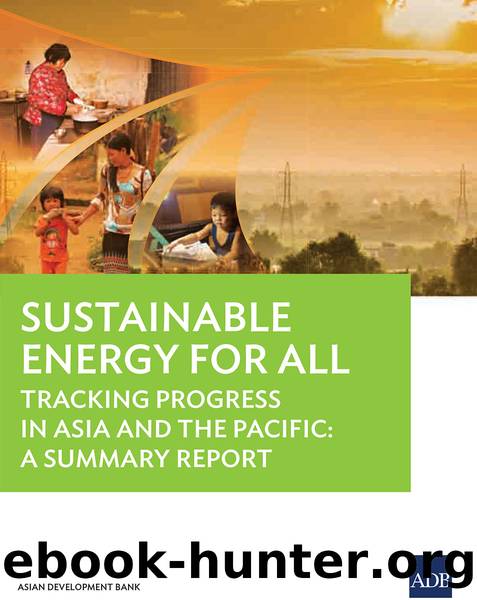Sustainable Energy for All Status Report by Asian Development Bank;

Author:Asian Development Bank;
Language: eng
Format: epub
Publisher: Asian Development Bank Institute
Published: 2015-08-15T00:00:00+00:00
ENERGY-WOMEN-CHILDREN-HEALTH NEXUS
3 The EnergyâWomenâChildrenâHealth Nexus
Introduction
How does gender affect access to energy services, and vice versa? On the one hand, because their subsistence and productive tasks give them a significant role in energy systems, women are disproportionately affected by energy poverty. At the same time, their lives, as well as menâs lives, can be transformed by access to energy. There is less manual labor, more comfort and convenience. Polluting energy forms, such as fuelwood and kerosene, are less used. New income-generating options arise, existing opportunities improve, and information and entertainment become more accessible.
Men and women, however, differ in their energy needs and access. They may therefore also experience the impact of energy services differently. According to the World Bankâs Gender at Work report (2014), âon virtually every global measure, women are more economically excluded than men.â Compared with men, fewer women in less developed regions have cash income. Women account for two-thirds of the worldâs 774 million adult illiterates, spend at least twice as much time as men doing unpaid domestic work, and, if employed, spend an inordinate amount of time and energy juggling work and family responsibilities. Their lack of official rights or ownership of resources limits their economic autonomy and leaves them defenseless against economic or environmental shocks. In South Asia, women earn only 20%â40% of what men earn, even after factors such as education and employment type are taken into account. To ensure equitable access to energy, these differences must be factored in.
Moreover, women and children bear the brunt of the negative effects of energy poverty. Without access to modern energy, they are subjected to the ills of indoor air pollution, and are often tasked in the laborious chore of collecting fuel. These burdens can cause serious impact on their health and security. This section outlines key trends in the energyâwomenâchildrenâhealth nexus in Asia and the Pacific.
Download
This site does not store any files on its server. We only index and link to content provided by other sites. Please contact the content providers to delete copyright contents if any and email us, we'll remove relevant links or contents immediately.
Life 3.0: Being Human in the Age of Artificial Intelligence by Tegmark Max(5193)
The Sports Rules Book by Human Kinetics(4079)
The Age of Surveillance Capitalism by Shoshana Zuboff(3995)
ACT Math For Dummies by Zegarelli Mark(3855)
Blood, Sweat, and Pixels by Jason Schreier(3498)
Unlabel: Selling You Without Selling Out by Marc Ecko(3474)
Hidden Persuasion: 33 psychological influence techniques in advertising by Marc Andrews & Matthijs van Leeuwen & Rick van Baaren(3302)
Urban Outlaw by Magnus Walker(3246)
The Pixar Touch by David A. Price(3220)
Bad Pharma by Ben Goldacre(3102)
Project Animal Farm: An Accidental Journey into the Secret World of Farming and the Truth About Our Food by Sonia Faruqi(3019)
Brotopia by Emily Chang(2899)
Kitchen confidential by Anthony Bourdain(2835)
Slugfest by Reed Tucker(2807)
The Content Trap by Bharat Anand(2781)
The Airbnb Story by Leigh Gallagher(2707)
Coffee for One by KJ Fallon(2424)
Smuggler's Cove: Exotic Cocktails, Rum, and the Cult of Tiki by Martin Cate & Rebecca Cate(2341)
Beer is proof God loves us by Charles W. Bamforth(2253)
